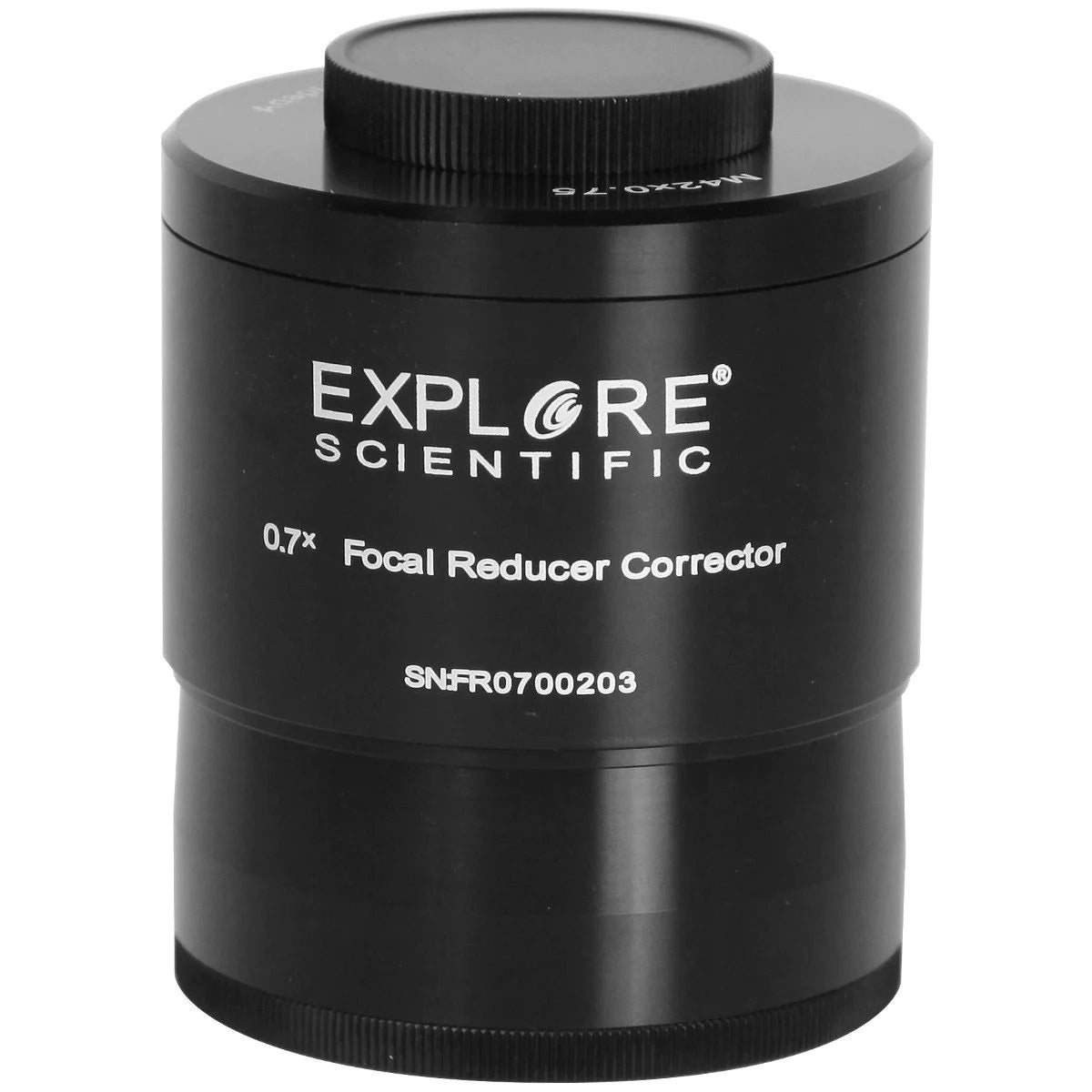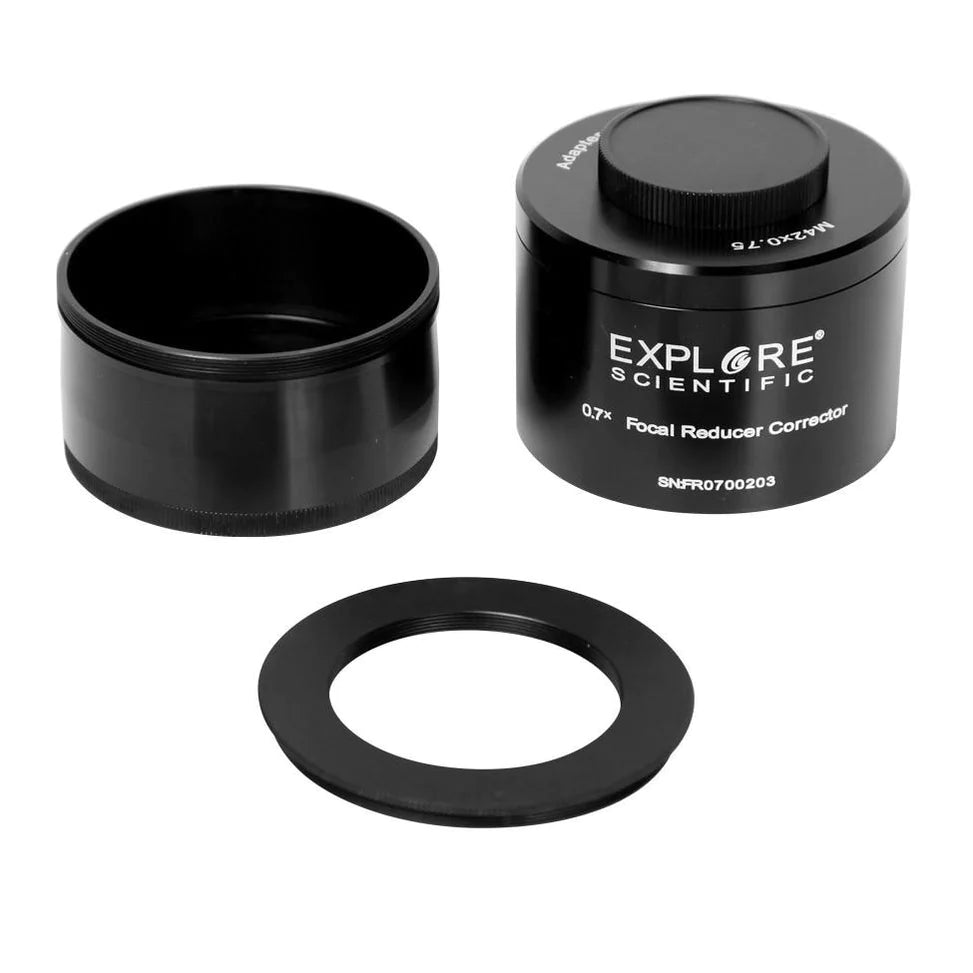
Explore Scientific 3" Field Flattener .7x Focal Reducer
Explore Scientific 3" Field Flattener .7x Focal Reducer is backordered and will ship as soon as it is back in stock.
Shipping & Returns
Shipping & Returns
We offer free US standard shipping on orders over $99 and 30-day returns on most items. Some limitations apply.
Shipping Policy
30-Day Return Policy
Sharper, Brighter, Faster: The 0.7x Focal Reducer for Serious Astrophotographers
Want sharper, distortion-free images of the stars? Get the Explore Scientific field flattener and focal reducer for crisp, wide-field shots with less exposure time.
Features
- Designed for Astrophotography and Astro-Imaging: Enhance your astrophotography with sharper, distortion-free images, perfect for capturing celestial wonders.
- Compatible with 3" Focusers: Easily integrates with 3" focusers for seamless connection to your telescope setup.
- Corrects Spherical Aberration: Eliminates edge distortion and ensures crystal-clear images across the entire field of view.
- 0.7x Focal Reduction: Widens the field of view and reduces your telescope’s focal ratio, delivering brighter images and shorter exposure times.
- Fully Multi-Coated Optics: Maximizes light transmission and minimizes reflections for superior image clarity.
- Lightweight and Durable: Weighing only 1.4 lbs (0.64 kg), this field flattener/focal reducer is easy to handle and built to last.
The Explore Scientific 3" Field Flattener/0.7x Focal Reducer is for you if…
- You’re an Astrophotographer: Looking to capture sharper, edge-to-edge celestial images with your refractor telescope.
- You Struggle with Long Exposure Times: Want to reduce exposure time while still getting bright, detailed shots of the night sky.
- You Want to Widen Your Field of View: Need to capture more of the night sky in a single frame without sacrificing image quality.
- You’re Frustrated by Spherical Aberration: Tired of blurry or distorted edges in your images and need a reliable solution to flatten the field of view.
- You Value Precision and Compatibility: Looking for a field flattener that provides exact back-focus measurements for accurate and effortless setup with your camera system.
If you're an astrophotographer, you know that sharp, distortion-free images are key to capturing the beauty of the night sky. The Explore Scientific 3" Field Flattener/0.7x Focal Reducer is designed specifically to address two of the most common issues you face: edge distortion and long exposure times. With this accessory, you’ll eliminate spherical aberration, ensuring that your images are crisp and clear from the center all the way to the edges. Whether you’re imaging galaxies, star clusters, or nebulae, this field flattener ensures that the full frame of your image remains in perfect focus, so you don’t have to deal with blurred edges or out-of-focus areas.

What makes this focal reducer even more powerful is its ability to reduce your telescope’s focal ratio by 0.7x, giving you a wider field of view and brighter images. For example, using this with an f/8 refractor will transform it into an f/5.6 system, while an f/7.5 refractor becomes an f/5.25 system. This reduction allows you to capture more of the sky in a single frame, which is crucial for imaging large celestial objects or wide star fields. Plus, with the focal ratio reduced, exposure times are significantly shorter, meaning you can capture bright, detailed images without spending hours waiting for the perfect shot. This is especially important for objects like faint nebulae, where long exposures often lead to blurring from Earth’s rotation or other movements.
Compatibility is a breeze. This accessory is recommended with Explore Scientific 127mm and 152mm refractors—excluding the doublet refractors—and can be easily attached to 3" focusers. It comes with a threaded adapter that fits a 2-inch rack-and-pinion focuser, and with the additional adapter, it’s also compatible with the 2.5-inch hex focuser found on the Explore Scientific 127mm APO telescopes. The exacting 55mm back focus ensures perfect optical alignment, while the included M42x0.75 adapter adds 3mm, so the camera sensor needs to be 52 mm from the face of the adapter. This level of precision makes achieving ideal focus and alignment straightforward, allowing you to spend more time capturing images and less time troubleshooting your setup.

The optics are fully multi-coated, which maximizes light transmission while reducing reflections and ghosting, critical for ensuring high contrast and bright images. Whether you're shooting under light-polluted skies or in darker environments, this coating makes sure every photon of light is captured with maximum efficiency, helping you get the clearest, most vibrant results possible. At 1.4 lbs (0.64 kg) and with compact dimensions of 90.1mm in height and 78.3mm in diameter, the unit is both lightweight and highly portable, making it easy to incorporate into your setup without adding unnecessary bulk.
If you’re using Explore Scientific’s 127mm or 152mm refracting telescopes and want to dramatically improve your astrophotography, the 3" Field Flattener/0.7x Focal Reducer is the accessory you need. It corrects spherical aberration for edge-to-edge sharpness, widens your field of view, and reduces your exposure times—all while offering seamless integration with your existing gear. Stop struggling with long exposures, narrow fields, and blurry edges, and start capturing the sky in stunning clarity with this essential upgrade.
-
Item Number
-
Barrel Size
-
Dimensions
-
Weight
-
Warranty
Payment & Security
Payment methods
Your payment information is processed securely encrypted during transmission. We do not store credit card details nor have access to your credit card information.
Questions & Answers
Have a Question?
Be the first to ask a question about this.










